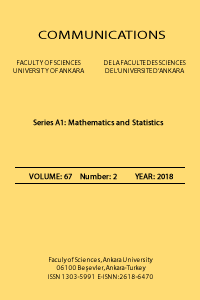Inverse stereographic hyperbolic secant distribution: a new symmetric circular model by rotated bilinear transformations
circular distribution, inverse stereographic, bilinear transformation, Mobius transformation rotation,
___
- Chaubey, Y. P., Karmaker, S. C., On some circular distributions induced by inverse stereographic projection, Sankhya B (2019), 1-23. https://dx.doi.org/https://doi.org/10.1007/s13571-019-00201-1.
- Dattatreya Rao, A., Girija, S., Phani, Y., Stereographic logistic model-application to noisy scrub birds data, Chilean Journal of Statistics, 7(2) (2016), 69-79.
- Fisher, N. I., Lewis, T., Embleton, B. J., Statistical Analysis of Spherical Data, Cambridge University Press, 1993.
- Girija, S., Rao, A., Yedlapalli, P., On stereographic lognormal distribution, International Journal of Advances in Applied Sciences, 2(3) (2013), 125-132.
- Girija, S., Rao, A. D., Yedlapalli, P., New circular model induced by inverse stereographic projection on double exponential model-application to birds migration data, Journal of Applied Mathematics, Statistics and Informatics, 10 (1) (2014), 5-17. https://dx.doi.org/https://doi.org/10.2478/jamsi-2014-0001.
- Kato, S., Jones, M., A family of distributions on the circle with links to, and applications arising from, Möbius transformation, Journal of the American Statistical Association, 105(489) (2010), 249-262. https://dx.doi.org/https://doi.org/10.1198/jasa.2009.tm08313.
- Mardia, K. V., Jupp, P. E., Directional Statistics, vol. 494, John Wiley & Sons, 2009.
- Minh, D. L., Farnum, N. R., Using bilinear transformations to induce probability distributions, Communications in Statistics-Theory and Methods, 32(1) (2003), 1-9. https://dx.doi.org/https://doi.org/10.1081/STA-120017796.
- Needham, T., Visual Complex Analysis, Oxford University Press, 1998.
- Swain, J. J., Venkatraman, S., Wilson, J. R., Least-squares estimation of distribution functions in johnson's translation system, Journal of Statistical Computation and Simulation, 29(4) (1988), 271-297. https://dx.doi.org/https://doi.org/10.1080/00949658808811068.
- Yedlapalli, P., Girija, S., Dattatreya Rao, A., Srihari, G., Symmetric circular model induced by inverse stereographic projection on double Weibull distribution with application, International Journal of Soft Computing, Mathematics and Control, 4 (2015), 69-76. https://dx.doi.org/https://doi.org/10.14810/ijscmc.2015.4106
- Yedlapalli, P., Sastry, K., Rao, A., On stereographic semicircular quasi lindley distribution, Journal of New Results in Science, 8 (2019), 6 -13.
- ISSN: 1303-5991
- Yayın Aralığı: Yılda 4 Sayı
- Başlangıç: 1948
- Yayıncı: Ankara Üniversitesi
Chingiz HASHİMOV, Javad ASADZADEH
Mehmet YILMAZ, Hüseyin ÜNÖZKAN
Sayed ZEESHAN, Gajendra K. VİSHWAKARMA, Manish KUMAR
